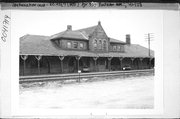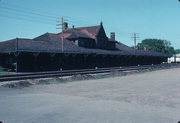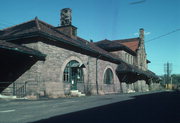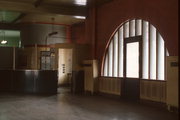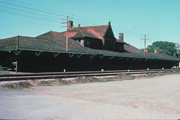Property Record
324 PUTNAM ST
Architecture and History Inventory
| Historic Name: | Chicago, St. Paul, Minneapolis & Omaha Railroad Depot |
|---|---|
| Other Name: | Chicago & Northwestern Railroad Depot |
| Contributing: | |
| Reference Number: | 41714 |
| Location (Address): | 324 PUTNAM ST |
|---|---|
| County: | Eau Claire |
| City: | Eau Claire |
| Township/Village: | |
| Unincorporated Community: | |
| Town: | |
| Range: | |
| Direction: | |
| Section: | |
| Quarter Section: | |
| Quarter/Quarter Section: |
| Year Built: | 1893 |
|---|---|
| Additions: | |
| Survey Date: | 1987 |
| Historic Use: | depot |
| Architectural Style: | Romanesque Revival |
| Structural System: | |
| Wall Material: | Brownstone |
| Architect: | Charles Frost |
| Other Buildings On Site: | |
| Demolished?: | Yes |
| Demolished Date: | 1987 |
| National/State Register Listing Name: | Chicago, St. Paul, Minneapolis & Omaha Railroad Depot |
|---|---|
| National Register Listing Date: | 10/24/1985 |
| State Register Listing Date: | 1/1/1989 |
| National Register Multiple Property Name: | Multiple Resources of Eau Claire |
| Additional Information: | DEMOLISHED in 1987 to expand Holsum Bakery. According to the 1987 survey update: Severe deterioration of wood framing and details. A major portion of tile from the roof of the waiting area has been removed to patch the main structure or is on storage. The depot, located on the city's near north side in an industrial area, is a long low structure constructed of rock-faced Lake Superior brownstone laid in irregular courses. On the main facade which faces the railroad tracks, a two story component "rises through" the continuous camel-back hip roof that is covered by red tiles. This element which is capped by a hip roof is intersected by a gabled projection identified by a shouldered triangular parapet. Three roundheaded openings accented by smooth stone voussoirs are within the projection. According to an article in the Architectural Review, the second story contained some of the division offices (B). Below, on the ground level, the center section is characterized by two broad, round arched openings, Richardsonian trademarks, which serve as the main entrances to the waiting room and ticket area. The glassed portion of the openings is divided by wooden mullions. Between the two arches is a slightly projecting feature which indicates the ticket office. The glassed portion of this element is rectangular and once again divided by mullions. Flanking the center are one story sections which contain additional round arched openings, one to the east and two to the west. These windows aer separated into small panes and, like all the arched openings, outlined by smooth stone voussoirs. Extending laterally from the main block of the depot are an open waiting area (to the east) and a baggage and express area (to the west). The baggage and express building is connected to the depot by the low sloping roof but is separated by an open passage. This portion of the building, the feature most common in Frost's stations, is relatively unadorned with rectangular windows and doors breaking the wall surface. A small rounded projection at the northeast corner contains the telegraph office. At the opposite end of the depot is an open waiting space, also sheltered by the roof which is supported by heavy stone piers. In addition, the roof extends beyond the front of the entire building to cover the region immediately adjacent to the tracks. The roof here rests on wooden posts with radiating brackets. The rear of the building presents a nearly identical design. The gabled projection on this elevation features an exterior chimney with a narrow round arched opening to either side. The main entrances on the first floor are protected by a bracketed roof. The depot's Art Moderne interior is also significant. Totally remodelled in 1941 (B), the interior, incorporating the arched elements already in place, features rounded corners and little wall decoration to create an appropriate "streamlined" feeling. The depot is still in use though on a very limited basis as passenger train service was discontinued in 1963. The structure is in fair to poor condition. Reflecting the need to recognize the importance of the depot and to insure its survival, the Eau Claire Landmarks Commission has recently designated the building a local landmark. The Chicago, St. Paul, Minneapolis & Omaha Railroad Depot, an identifiable Charles Frost-designed station, is an architecturally significant resource within the city representing both a type and a period of construction. Erected in the Richardsonian Romanesque manner, the depot in Eau Claire is one of several in Wisconsin designed by Frost, who was recognized for his contribution to small railroad station design. Using local materials and incorporating specific construction principles, the Eau Claire depot is a fine representation of Frost's work and of Richardsonian Romanesque architecture. Charles Frost, born in Maine in 1856, studied architecture at MIT and was then employed in the Boston office of Peabody and Stearns. In 1881 Frost moved to Chicago where he entered a partnership with Henry Ives Cobb which was dissolved in 1889. From that year until 1898 Frost practiced alone and during that time the Eau Claire depot was designed and constructed. Frost next practiced with Alfred Hoyt Granger, forming the Frost and Granger partnership which also specialized in depot design. Frost's marriage in 1885 to Mary Hughitt, the daughter of the Chicago & Northwestern Railway's president, gave him access to railroad commissions that allowed him to incorporate his design ideas into the plans for several new depots erected on the Chicago & Northwestern lines (D). Frost summed up his architectural philosophy with the following statements: "Architecturally the building should express its purpose, and when possible, also give some hint as to the character of the twon or city it serves. Above all things, as it is intended for a waiting place, the shelter feature must be strongly developed" (A). In Wisconsin a number of Frost and Frost and Granger stations are already listed in the National Register of Historic Places. Among these are the Watertown Depot (NRHP 1979; 1903), the Lake Geneva Depot (NRHP 1978; 1891), the Oconomowoc Depot (NRGP 1980; 1896), and the South Milwaukee Depot (NRHP 1978; 1893). In 1870, two years before the city of Eau Claire was incorporated, the first train arrived in the lumber community. A long awaited event, the occasion represented the end of an intense effort to bring train service to Eau Claire. The incorporation of the Chippewa Valley Railroad Company signalled the initial attempt "to bring a railroad from the Mississippi RIver to Eau Claire parallel to the Chippewa" (E). Unfortunately the Panic of 1857 intervened and the project was halted. In 1863 the Tomah and Lake St. Croix Railroad Company was organized by a number of prominent men from the counties of west central Wisconsin. Joseph G. Thorp and Richard F. Wilson represented Eau Claire county's interests (E,F). Construction on the road began in Tomah in 1867 and reached Eau Claire as mentioned previously in 1870. By this time the line was the West Wisconsin Railway which had taken control of the Tomah & Lake St. Croix Company in 1866 (E). Mergers and bankruptcies occurred with regularity until 1900. In 1878 the bankrupt West Wisconsin was purchased by the Chicago, St. Paul & Minneapolis Railway Company which added "Omaha" to its name in 1880 after a merger with the North Wisconsin Railway Company (E). Two years later, the majority of the stock in the Chiago, St. Paul, Minneapolis & Omaha line was purchased by the Chicago & Northwestern Company. The Omaha road continued to operate under its own name but was connected to the C&NW system (G). |
|---|---|
| Bibliographic References: | (A) Architectural Reviewer. Sept. 1897, pp. 19-47. (B) Eau Claire Leader, Nov. 23, 1941, p. 18. (C) Eau Claire Leader, June 13, 1941. (D) Withey, H.R. and E.R. 1970. Biographical Dictionary of American Architects Deceased, p. 224. (E) Peterson, D. 1970. "Lumbering on the Chippewa: The Eau Claire Area, 1845-1885." PhD. dissertation, University of Minnesota. (F) Stennett, W. 1910. Yesterday and Today: A History of the Chicago and Northwestern Railway System, p. 79. (G) Raney, W. 1936. "The Building of Wisconsin Railroads." Wisconsin Magazine of History, 19:307-403 Eau Claire Leader Telegram 6/23/1999.. |
| Wisconsin Architecture and History Inventory, State Historic Preservation Office, Wisconsin Historical Society, Madison, Wisconsin |

